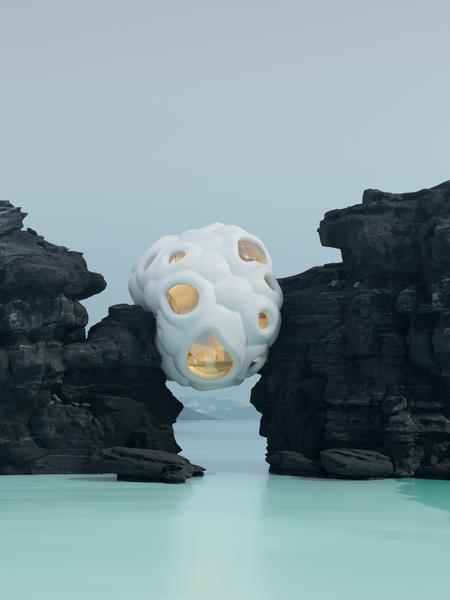This year, land grabs exploded, but anyone buying one of these parcels really has to use their imagination in order to realize a property’s potential.
In the spring of 2021, a pre-vaccine public desperate for yet another new hobby that could be done via computer found out about web3 and the blockchain. Instead of just trading cryptocurrency like Bitcoin around, the power of the blockchain had been harnessed for something called NFTs, or non-fungible tokens. The gist of NFTs—and I’m sure that even the most generous and open-minded way I could phrase this will make the NFT guys mad—is something like: "What if instead of being able to copy a digital file, you couldn’t? And what if transferring that file to someone else was really annoying and needlessly complicated, thus making the file worth some dollar amount?"
NFT technology can be applied to pretty much anything. A token is minted on the blockchain, and that means that it and whatever it corresponds to (a file or a URL, usually) is unique, and that only one person can own the token at that time. An NFT is like a deed—there is nothing to stop the file from actually being duplicated. NFTs have, in other words, introduced the concept of finite resources and scarcity to the internet, where neither of those concepts had really existed before. Obviously, this set off a land rush.
Welcome to the world of NFT real estate, where you can spend real money on fake money and then use that fake money to buy a parcel of land that does not actually exist in the physical realm and only exists in the metaverse. (The "metaverse" is a term whose meaning depends on which Fortune 500 VP of Marketing you ask, but a good aggregate definition is, "Imagine if the whole internet was a jankier version of The Sims.") By the beginning of February 2022, CNBC was reporting that "Metaverse real estate sales top $500 million, and are projected to double this year." A few months later, the overall market for crypto cratered.

Six N. Five’s Make Room For Us for The Row.
Image courtesy of The Row
Still, NFT geography can be found for sale across plenty of marketplaces online. Parcels for Decentraland, a blockchain-based virtual world, can be found on various popular NFT marketplaces like OpenSea. Anyone buying one of these parcels really has to use their imagination in order to realize a property’s potential. For instance, one recent listing offers a "[fire emoji]Great Parcel Near Manhattan"—the listing’s picture is a tiny red square, representing the parcel, amidst a sea of surrounding gray squares. Other parcels are in "Downtown" or by the "Museum District" and present a similar red square. Where is Manhattan? Where is Downtown? All of this feels excessively arbitrary and tedious in a virtual environment where commute times don’t matter. Do I really need a parcel in Digi-Greenwich Village when a commute is a few clicks and keystrokes?
This land is—theoretically!—worth a lot. At crypto’s value peak in November of 2021, the firm Tokens.com spent 618,000 MANA (the equivalent of $2.43 million at the time) on 116 "parcels" of "land" in Decentraland. That cryptocurrency, used as part of what was then "the largest metaverse land acquisition in history," is now worth less than $200,000.
Once you look past the land grabs, there’s not much else to see. There are, based on an overview of a number of popular NFT marketplaces, relatively few structures—buildings, houses, apartment complexes, event spaces—up for sale. The ones that do exist exist at one of two poles: overly conceptual or extremely rudimentary.
The metaversal real estate firm Everyrealm, to name one example, has crafted The Row, a collection of properties from artists that are completely useless in the sense that they are both architecturally underwhelming and exist only on the computer. One has a giant, decaying Greco-Roman bust in front of a wading pool amid a rocky barren wasteland. Another shows a blocky, see-saw shaped house in the desert. A third asks, "What if that glass cube Apple Store was a house in a swamp?" One is just a pill-shaped obelisk in a barren environment.
In early 2021, the artist Krista Kim sold an NFT for a structure called Mars House. It looks, to put this delicately, like the sort of thing someone would make after messing around with Photoshop and discovering the opacity slider and gradient tools for the very first time. All of the furniture is translucent and shiny, like iMacs and video game consoles from the turn of the century. The colors morph and warp in basic ways. The entire structure is entirely lacking in texture or friction. It feels as if stepping in any direction will send you careening through one of the many glass-like features and over the structure’s edge.

Krista Kim’s Mars House.
Photo courtesy of Krista Kim
All of these constructions evoke the aesthetic of "vaporwave," a subgenre of electronic music whose biggest appeal was its visual packaging: pastel colors reminiscent of a 1980s that never really existed and invocations of the blocky user interfaces of Windows 95 and Mac OS. I had a touch of déjà vu until I realized that all of the NFT architecture I was looking at reminded me of the album art for Vektroid’s seminal album "Floral Shoppe."
Other architectural ventures in the metaverse fare even worse. Popular virtual world The Sandbox offers an aesthetic approach that utilizes voxels (volumetric pixels) to create its world. It is, in essence, Minecraft with a little more detail and an exponentially high barrier to entry. (Also, Snoop Dogg is there.) Horizon Worlds, the offering from Meta, the company formerly known as Facebook, feels similarly basic, brightly colored and flatly textured. And for all of the architectural features that might be on display, none get put to use. What’s the point of stairs when avatars don’t (currently) possess legs? What’s the point of seating when avatars don’t have an ass? Everything is a facsimile of the real world, rather than a new paradigm of virtual interaction.
One of the big issues with many of these virtual domiciles is light. One Decentraland video tour shows a marketing effort from J.P. Morgan, showing neon signs blaring all over the environment. But somehow, they don’t cast shadows or tint their surroundings. In many modern, big-budget video games, light comes from designated sources, and how it plays off of various surfaces and different textures is calculated with relatively minute detail. In the metaverse, the light comes from nowhere. There are few shadows and no reflections, just flat shades, like a particularly poorly digitally staged apartment. Technologically, it makes the metaverse more easily accessible by not requiring users to possess hardware with serious rendering power. Effectively, it also makes the metaverse look like a fake video game from crime procedural, or like one of those cheap CGI YouTube videos meant for children. The current state of NFT housing is "paying six figures to live in the world of CocoMelon."
The only structures in the metaverse not seemingly meant to be sold are designed to sell something else. Just last week, McCormick Spice unveiled its House of Flavor in Decentraland. The YouTube video promoting it (430 views so far) has users standing around, stone still, in a beige, bunker-like meeting space extolling the virtues of McCormick’s various spice and flavor enhancers, presented as an art gallery, or as movie posters outside a theater that doesn’t exist. The avatar conducting the silent tour eventually walks outside, to reveal a marketing mural on one side of the building that would not look out of place in any of the gentrifying neighborhoods across the country—the form of graffiti repurposed for generating capital. Ironically, it only makes the McCormick House of Flavor seem even blander.
Top image of Daniel Arsham’s metaverse real estate for The Row, courtesy of The Row.
Related Reading:
The ‘Selling Sunset’ Theory
Artist Gab Bois Isn’t Afraid to Play With Food—or Turn It Into Furniture
Read More
By: Brian Feldman
Title: You Can Build Anything in the Metaverse, Especially a Déjà Vu-Inducing, Unlivable House
Sourced From: www.dwell.com/article/nft-crypto-metaverse-real-estate-houses-design-a599d9ac-33111025
Published Date: Wed, 21 Dec 2022 18:35:00 GMT
.png)





